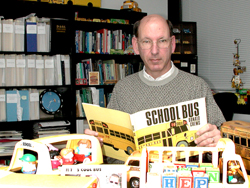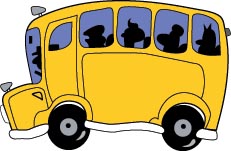|
 Usually, scores of school buses would require a lot of space. But somehow, through creative decoration and furniture arrangement, Jeff Raffel, director of the School of Urban Affairs and Public Policy, has made them all fit into his office in Graham Hall. Usually, scores of school buses would require a lot of space. But somehow, through creative decoration and furniture arrangement, Jeff Raffel, director of the School of Urban Affairs and Public Policy, has made them all fit into his office in Graham Hall.
Raffel first began collecting school buses, not full size but miniature ones, and other school bus keepsakes after he got involved in the desegregation of Delaware schools, which used busing to integrate public schools in New Castle County. As executive director of a government appointed committee, he helped successfully implement a federal court order, which led to the desegregation and reorganization of the Wilmington and surrounding suburban school districts.
At a celebration party in 1978 for the committee peacefully accomplishing this difficult change for the community, Raffel received his first school bus–a 5-inch, canary yellow model with functioning wheels, which he still has in his office.
“I once read that intelligent people tend to collect things,” he said. So, he took this idea, and with the help of his wife, Joanne, and her love of shopping, began a collection of his own. The result being that every corner of Raffel’s office is filled with school buses of all shapes, sizes, colors and nationalities.
“My wife is a wonderful shopper, she’s just superb,” he said displaying his bus nameplate and bus tape holder she bought him at a craft fair.
His wife also does needlepoint and she stitched Raffel a ruler with an academic insignia on it. Also, the grandfather of three has pictures of his grandchildren peeking out of the windows of school bus picture frames all around his office.
“There is some sentiment to these, too,” he said, handling a small ceramic bus his wife and daughter, Alison, had made for him at a favorite vacation spot in Stone Harbor, N.J. “Cute, right?” he said, showing the bottom of the ceramic bus, which read “Time to Kiln Company.”
“[Collecting] has some meaning to me,” he said. “It’s also been interesting to see how one American icon or symbol is located in so many different places.”
Raffel travels extensively and said he started to find school bus souvenirs on his excursions through Europe, the Caribbean and Asia.
“It really got interesting,” he said. “You walk into a department store in Holland and you wouldn’t think they‘d have these kinds of school buses, but there they are.”
He even found one at a market square in Spain, he said lifting the member of his yellow fleet off the windowsill. “Made in China,” he said, laughing. “You never know where you’re going to be when you see one of these things.”
 The world traveler also has many Fisher-Price toys, including a small plastic bus, still in its box, with an identical twin sister, except the writing on one box is in German.
The world traveler also has many Fisher-Price toys, including a small plastic bus, still in its box, with an identical twin sister, except the writing on one box is in German.
“It’s a worldwide toy,” he said.
School buses also are apparently “people-wide” too. Raffel said a person who was walking by his office once, saw his collection from the window and came in to say hello. It turned out the man’s parents had been private contractors of school buses and he also had a collection of the youthful icon.
Another time, Tim Barnekov, acting dean of the College of Human Services Education and Public Policy, was visiting Raffel’s office when he noticed a copy of a book his grandmother wrote, “The Bingity Bangity School Bus,” which Raffel’s daughter, Lori, had bought at a garage-sale. Barnekov even autographed Raffel’s copy of the 1950s book.
Raffel has a host of other school bus souvenirs including Christmas-tree ornaments, earrings (he has never worn), a rug, bookends (surrounding the three books he’s written on school desegregation), a cookie jar with a teddy bear driver and a tie, to mention a few. A couple of his favorites are a wooden bus with Beanie Baby passengers and an antique he bargained for at a furniture shop because the bus item wasn’t for sale.
Framed on his wall is a greeting card from Faneuil Hall in Boston, picturing a yellow-green melon with mushroom wheels.
“One question I’ve have to deal with,” he said, “ is, when is a school bus not a school bus? At what point are you really going over the edge.
“Some say I’ve probably gone over there,” he added.
One of the buses Raffel didn’t buy was a remote control model from Radio Shack.
“It was very tempting as an administrator to buy that and then I could send messages to the faculty from my office,” he said, “but I thought that might just be a little nuts.”
The administrator said his collection has gotten so large that he has a few additions waiting to come to his office, if he can make room. Right now he’s trying out new shelving as a way to display and organize his fleet.
Raffel said he tries not to pay more than $30 for any piece of his collection. With close to 150 members in the group, at an average cost of $20, he mentally calculated what he has spent. “Ooh, that’s a lot of money,” he said, “but that’s been over a long time.”
He added that he probably didn’t spend that much because much of his collection is made up of small items, like stickers. He said he thinks most of the pieces aren’t worth a lot of money and hasn’t really thought about who will inherit his special treasures.
But until they’re passed along, Raffel said, “Come over and play anytime.”
Article by Laura LaPonte
Photograph by Kathy Flickinger
April 26, 2002
|

